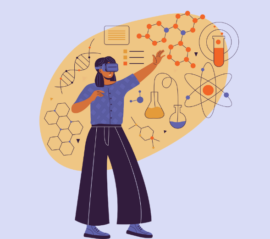Science marketing is an ever-evolving discipline. Advances in technology mean new channels to market as media platforms continue to emerge. Improvements in connectivity has seen us consuming content in more places than ever before. Part of the role of marketers is to understand, embrace and master these new dynamics and science marketing trends.
The COVID-19 pandemic saw online working, commerce, communication, and entertainment become a significant focal point of daily life. It taught life science marketers that a strong, unified online presence across the digital marketing trifecta of earned, paid, and social media is vital. In this blog post, we look at five contemporary science marketing trends worthy of further investigation in the year ahead.
#1 Brand Connections Through Targeted Personalized Marketing
Customers have more choices than ever before, and are more informed and selective as to what they consume. Audiences choose exactly what to listen to, watch and, ultimately, purchase and use. They opt into a brand’s ecosystem through permission marketing. This enables brands in highly competitive and often global markets to work smarter to first engage customers and then retain their business. No surprises, then, that personalization has become a hot topic in marketing. Personalization leverages consumer and other data collected online – such as purchase history, demographic information, body measurements, location, even weather – to present personalized offers, recommended products, and other content.
Most of us will already be aware of personalized marketing, though it can be very subtle. For example, when we purchase from Amazon, we see ‘customers also bought’ or ‘often purchased together’ recommendations. If you click on a native Facebook ad, it’s common to see that populated in your Instagram feed too as cross-pollination takes place. On Netflix, we see customized homepages with watchlist recommendations based on viewing history and search terms. In fashion, brands such as Stitch Fix focus on building intimate relationships by making personalized style recommendations for customers based on data they provide. This data includes body measurements, personal style preferences, and other feedback. As customers work with Stitch Fix stylists, their profile evolves and more informed recommendations can be made.
Science Marketing Trends in Personalization
Personalization is increasingly integrated into brand messaging and marketing strategies. This area of marketing will only become more advanced as AI and chatbot technology gets smarter. This area is still evolving in the life sciences and health sectors. However, the COVID-19 pandemic opened many peoples’ minds to digital health and telehealth. We are starting to see more personalized health recommendations from AI to answer non-urgent questions that don’t require a doctor. AI can escalate cases should a patient wish to see a doctor. More healthcare companies now offer secure patient portals where they can access Electronic Health Records, see test results, and fill prescriptions. Companies are exploring personalized content based on health data to make nutrition and exercise recommendations, and lifestyle management tips. As companies such as Apple, Amazon and Google engage the personalized health space, expect to see more opportunities to market directly to users.
#2 Short-Form Video Content Gains Serious Momentum
YouTube Shorts, Instagram Reels, the relentless rise of TikTok. There can be little doubt that short-format video is firmly established as a content heavyweight. In September 2021, TikTok reported 1 billion monthly active users worldwide, representing a 45 percent growth compared to the previously reported figure of 689 million Monthly Active Users (MAU) in July 2020. Instagram reported almost 1.4 billion users. While predominantly a consumer content-generated platform, TikTok is gradually finding its way into the business community.
Brands and health care providers (HCPs) now recognize the importance of using TikTok to reach younger demographics. While Instagram and Snapchat continue to attract an under 35 age group, TikTok’s core audience trends younger. An article by PharmaLive reports, “Whether it’s dispelling vaccine myths, giving tips on dealing with just-tightened braces, or giving an inside look at what it’s like to be an HCP, we’re seeing nurses, NPs, and MDs all using the platform to share important information with the 16-24 audience.”
Short-Form Video’s Lasting Impact
The ability of short-form video to drive engagement will generate increasingly creative content. Instagram’s algorithms favor Reels, and we are now seeing Reels appear on Facebook. So, it really is a case of more videos, more exposure! Along with the growth of TikTok, expect to see an increase in video used by brands in both short- and long-form applications across social media marketing, websites, email marketing, and advertising. Influencer and user content will continue to drive video growth in 2022. Reporting and tracking technologies are also becoming increasingly sophisticated, which helps show ROI to justify spend.
Influencer short-form video marketing remains a growth area for brands to cultivate. Customer-created videos add a degree of independence and authenticity to campaigns as they illustrate ‘proof of concept.’
#3 Livestreaming
Livestreaming has taken a significant foothold in the entertainment sector over the past couple of years. This is particularly true in areas such as gaming, eSports, and musical events. The trend is driven by COVID-19 forcing events to be held online, and bolstered by the improved robustness of technology and networks.
According to a report by Technavio, the live streaming market is set to grow by $25.19 billion from 2021 to 2026. The growth momentum of the market will accelerate at a CAGR of 13.47%. The year-over-year growth rate of the market in 2022 is 12.87%.
Livestreaming presents opportunities to brands both proactively through producing livestreams, and reactively, in terms of sponsoring third party livestreams. There are numerous dedicated livestreaming options, in addition to those commonly-used on social media platforms such as Facebook Live, Instagram Live, Twitter Live and YouTube Live.
Producing Livestreams
Livestreams can be used to communicate directly with key audiences openly and transparently, which has been shown to build trust. From news announcements, product launches, and analyst briefings, to company town halls or interactive Q&A sessions, livestreaming is cost-effective and efficient. It also allows a brand to showcase its personality and values. Audiences to get to know key executives or take a peek behind the scenes of an organization.
Third Party Opportunities
Livestreaming is driven by audience buy-in. Users actively choose to participate. A livestream offers highly-targeted sponsorship opportunities for brands at a fraction of the cost of more traditional broadcast advertising. Watch times for live content has risen by 250% according to Brian Albert, Google’s U.S. Managing Director of Agency and Brand Solutions.
Livestreaming is being embraced by science companies. For example, in the consumer aesthetics space, Scienjoy Holding Corporation and Jiada Hexin (Beijing) Science and Technology Ltd., an online-to-offline (O2O) aesthetic medicine platform, announced a “live streaming aesthetic medicine platform that uses Scienjoy’s proprietary technologies to bring together customers, live streaming broadcasters and aesthetic medicine institutions.” The platform combines Jiada Hexin’s network of over 200 certified institutions with Scienjoy’s live streaming broadcasters. This allows existing live streaming broadcasters to engage with viewers and attract new beauty broadcasters. It employs AI image analysis to help users explore treatment options on the fly to make aesthetic treatment recommendations based on shared photos, during livestreaming consulting sessions.
#4 The Rise and Rise of Influencer Marketing
The digitization of life has truly leveled the playing field when it comes to creative branding and marketing. Location is no longer a discriminatory factor, which has spurred organizations to become more creative in increasingly crowded markets and engage in influencer marketing. This is not a new concept. Influencers have been associated with brands since the early 20th Century, through advertising or more recently as spokespeople, sponsored users and endorsements.
What the social media revolution has ushered in is the rise of the social media influencer/content creators. These influencers broadly span two groups: Celebrities who have successfully leveraged their brand into social media, and dedicated content producers who have successful careers creating and sharing content and have built audiences organically.
According to Brian Mechem, co-founder of leading influencer marketing facilitator, GRIN, “2022 is the year of the creator.” The past year has seen a significant rise in the influencer economy and this is expected to continue. According to The Drum, “the influencer marketing business was worth $9.7 billion in 2020 and is expected to grow to $15 billion by 2022, with almost half of marketers saying they’re spending more than 20% of their budget on influencer content” as most see a positive ROI. A large proportion of influencer growth is due to TikTok’s rapid growth as a platform. In addition, Facebook is planning to pay $1 billion to creators through 2022. This move will entice more influencers to produce content, which widens the scope for businesses looking for niche creators that dovetail with their brand and messaging.
Finding the Right Influencers for Your Brand
Influencer marketing is now a key consideration for businesses who are seeking to align themselves with audiences ripe for their products or services and are willing to invest substantially in influencer marketing efforts across several social media or distribution channels. Appropriate influencers can be researched through ‘influencer marketplaces’ such as Influencer Marketing Hub. Of course, science is not without its own social media rockstars. Neil DeGrasse Tyson for example, pulls in 14.5 million followers on Twitter, Bill Nye some six million, while Professor Brian Cox nets around three million.
Dedicated programs and teams track influencers and work closely with them to prioritize video content production with creators.
Future of Influencers in Science Marketing
Expect to see more branded content in 2023 and beyond. More and more brands will start hiring content creators or purchase the assets of established creators as they seek to expand and cultivate deeper relationships with audiences through ‘third party’ endorsements. In line with the growth of Influencer Marketing, its measurement will become more sophisticated and granular. Brands are now able to track customer journeys from point of engagement to product choice to fulfillment and post-sale communications. Live ‘social commerce’ will also continue to gain traction as consumer brands are leveraging retail tools into social influencer content via embedded stores and online checkout, directly driving sales.
#5 Inclusive Marketing
Structural inequality, that is, systemic privileges created within an economy, has long been a societal issue. “Structural inequality seems to be worsening,” writes economic expert Kimberley Amadeo in an article written for The Balance. “The 2008 financial crisis saw the rich get richer. In 2012, the top 10% of earners took home 50% of all income. That’s the highest percentage in the last 100 years, according to a study by economists Emmanuel Saez and Thomas Piketty.”
The COVID-19 pandemic, allied to increasing political polarization, highlighted historic structural inequalities and divisions in society. The increased awareness mobilized grassroots movements focused on delivering greater diversity, equity and inclusion (DEI). This extends to consumer choices, with people scrutinizing the values that brands represent more than ever before. Consumers now ask, “Does an organization truly support diversity and inclusion both externally and internally?”
Importance of Representation
According to a November 2021 Deloitte Insights article, Authentically Inclusive Marketing, “new US Census data shows that in the past decade, the white population has declined for the first time in history, and people who identify as multiracial, Hispanic, and Asian are driving much of the population growth. A 2021 Gallup poll highlights that LGBTQ identity has risen from 3.5% in 2012 to 5.6% in 2020—and includes one in six among Generation Z (ages 16 to 26 in 2021). And the World Health Organization reports that globally, 15% of the population lives with a disability—a category of consumers that is rarely featured in representative advertising.”
Deloitte Insights surveyed 11,500 global consumers, and “found the youngest respondents (from 18 to 25 years old) took greater notice of inclusive advertising when making purchase decisions.” In addition, when they “examined the US results by ethnicity and race, respondents were up to two-and-a-half times more likely to be aware of a brand prominently promoting diversity when making a product or experience purchasing decision if they identified as Asian or Pacific Islander, Black or African American, Hispanic American, Native American or Alaska Native, or multiracial or biracial.”
Brands Leading the Way
Consumer brands have been engaging diversity in health and beauty for many years. Rihanna’s Fenty Beauty, for example, has been aggressive in terms of highlighting inclusive marketing and challenging industry stereotypes. The brand has gained rich praise for reflecting reality. Fenty Beauty had more than 130 million YouTube channel views in its first month and sales of more than $500 million in its inaugural year. The brand also developed the ‘body-inclusive’ Savage x Fenty fashion show for Amazon’s Prime Video that brought models from different gender, race and body type, center stage.
In healthcare, the American Heart Association (AHA) launched an initiative as part of Black History Month to encourage Black women to “reclaim their rhythm” and take control of their health.
“In recognition of the physical and emotional toll the global pandemic and structural racism has taken on Black women, AHA will help empower Black women to bring to light their overall mental and physical well-being by using and uplifting their voices and sounds.”
The campaign celebrated music as a unifying force and shared playlists by Black artists to get people moving, or to help them rest and relax. Instagram followers voted on their favorite playlists.
The Future of Inclusive Marketing
For brands to be truly representative, considering diversity in all forms is key to embracing inclusivity and building equity. This includes ethnicity, gender identity, age, education, economic status, beliefs, location, physical and mental ability. Brands must also recognize that people’s identities, their race, class, gender and other personal characteristics, ‘intersect’ with one another and overlap, and as such people are often not defined or identified by a single characteristic. People are more likely to connect to a brand not because of assumptions about their identity, but because it’s relatable to their personal experiences and they are committed to recognizing and addressing inequities or injustice in society through their activities.
It’s clear that consumers are increasingly invested in societal change and make purchasing decisions that align with their own values. Expect life science brands to follow suit as they figure out their specific value propositions for distinct groups of consumers.
Keywords: Custom Content, Digital Strategies, diversity, influencers, messaging, science marketing, video marketing
 Subscribe
Subscribe



